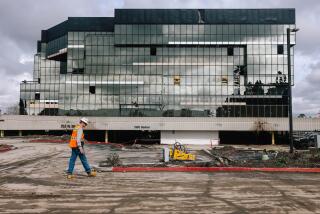IBM, Other U.S. Giants Slash Office Space : Economy: In the past three years, International Business Machines has vacated nearly half its U.S. office space--21 million square feet.
- Share via
WHITE PLAINS, N.Y. — Lee Dayton was anxious.
It was early 1993, and IBM was bleeding red ink. Dayton, IBM’s manager of real estate, ordered his staff to slash expenses for office space. They quickly responded, moving four employees into one wastefully big office.
His.
“I told my team that we’d better make an example of ourselves,” the manager recalled, grinning. “They came up with a plan which required me to evict myself.”
Dayton’s transfer to a smaller office in Stamford, Conn., was symptomatic of a change that is reshaping IBM and other parts of corporate America.
In the past three years, International Business Machines Corp. has vacated nearly half its U.S. office space--21 million square feet.
The shrinkage reflects IBM’s sharp decline in the highly competitive, DOS-eat-DOS era of personal computers. IBM has shed a third of its U.S. employees in the past three years.
The computer maker is not alone. Companies that have downsized their staffs are looking to do the same to their office buildings.
For example, Dayton’s group, in addition to pruning IBM’s space, has done consulting work to help American Express Co. and KPMG Peat Marwick reduce office space. A number of corporate giants, from AT&T; to Aetna, have embarked on space-reduction programs.
In a recent Arthur Andersen & Co. survey, nearly two-thirds of 700 corporate executives said they had recently shrunk their office space, or planned to.
“Over the last three years, they (companies) have been shedding workers like crazy. That has caused them to reassess how much space they need,” said William Wheaton, director of the center for real estate studies at Massachusetts Institute of Technology.
Some firms have gone so far as to “re-engineer the work space so they need less space per worker,” Wheaton said.
Analysts say a further decline for commercial real estate in the United States is unlikely, since smaller, growing businesses are moving into the empty space.
But some cities have been hit badly. In White Plains, 25 miles north of New York City, IBM has vacated five buildings. A thriving corporate center in the mid-1980s, it’s now dotted with glass-and-concrete shells. More than 25% of its office space is empty, one of the highest rates in the nation, said ONCOR International, a real-estate services firm.
IBM’s case is striking because of the amount of space it is cutting and its attempt to do more than simply dispose of unused offices. It’s trying to squeeze every penny out of its real estate, in what Dayton calls “a fundamental change in thinking.”
“You have to very matter-of-factly explain that having a private office or a given office size is not an entitlement,” he said.
At IBM, rank used to have its privileges. Ask Linda Bodden. In the old days, the 34-year-old branch manager would have had a personal branch manager’s secretary and a branch manager’s desk, which was bigger than a marketing manager’s desk.”
“To be a branch manager in the old days was to get the big corner office,” she said. “That was a big deal.”
These days, Bodden works out of clients’ offices, assisted by a car phone, beeper and a laptop computer. When she checks into the Cranford, N.J., IBM office every two weeks, she shares a small cubicle in an open space. It was, she said, a “cultural change.”
Five thousand of IBM’s 125,000 U.S. employees have similarly been forced to become mobile in the past few years, and IBM plans to double that number. Many share secretaries and take turns using a sort of communal desk.
More to Read
Inside the business of entertainment
The Wide Shot brings you news, analysis and insights on everything from streaming wars to production — and what it all means for the future.
You may occasionally receive promotional content from the Los Angeles Times.









